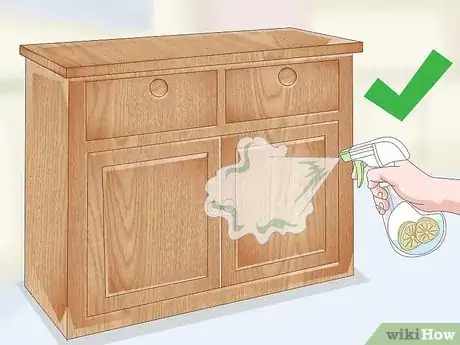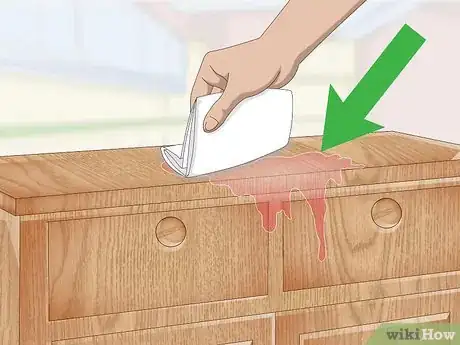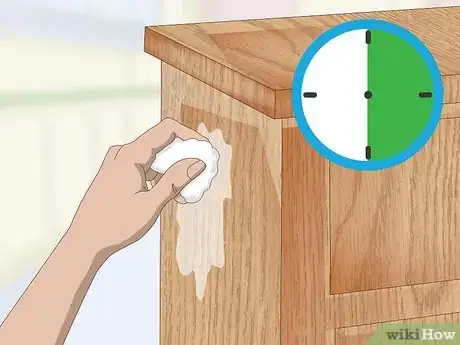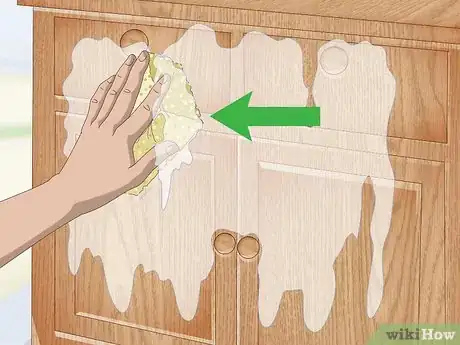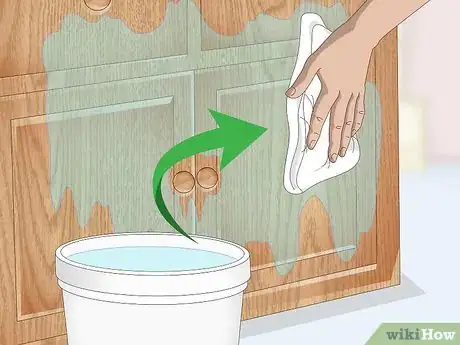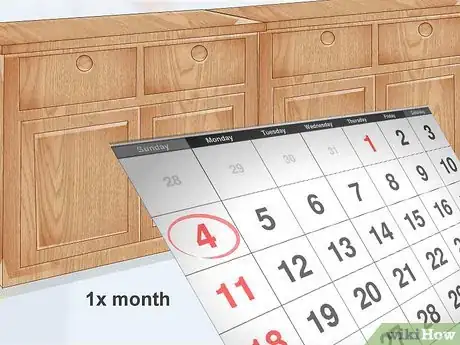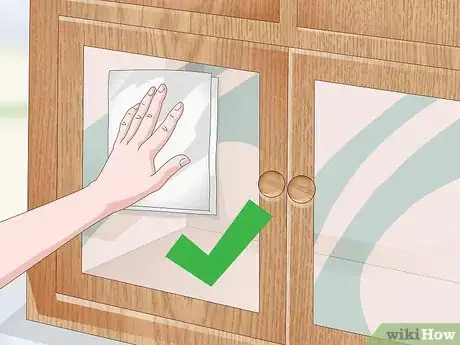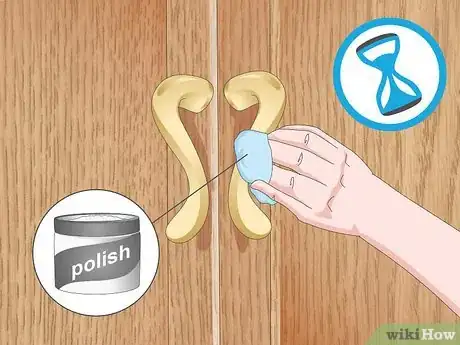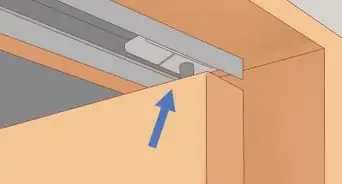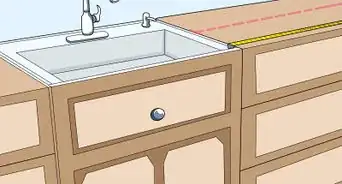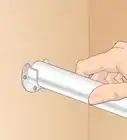This article was co-authored by Michelle Driscoll, MPH. Michelle Driscoll is the Owner of Mulberry Maids, which is based in Fort Collins, Colorado. With five years of experience, her business specializes in cleaning homes and small offices. She holds a Masters in Public Health from the Colorado School of Public Health. Additionally, Mulberry Maids has an A+ rating from the Better Business Bureau.
There are 11 references cited in this article, which can be found at the bottom of the page.
This article has been viewed 38,723 times.
Your cabinets get a great deal of use within your kitchen, so it is important to take care of them. To clean oak cabinets, start by selecting a non-abrasive cleaning solution. Mix this cleaning solution together in a bucket along with some warm water. Apply it to the cabinets using a sponge or cloth. Make sure to clean out the interior cabinet spaces as well.
Things You Should Know
- Protect your oak cabinets by choosing a non-abrasive cleaner—soapy water and diluted vinegar are good options, but you could also use a commercial cleaner made with citrus oils.
- If you need to scrub stubborn stains, make a paste out of baking soda and vegetable oil and apply it to the cabinet.
- Any time you notice a spill on your oak cabinets, clean it up right away to avoid permanent stains.
- When you're cleaning the cabinets, apply your cleaning solution with a soft sponge and always wipe in the direction of the wood grain.
Steps
Choosing a Cleaning Solution
-
1Use a citrus-based cleaner to add shine. Look for a product labeled as “orange polish” or “orange cleaner.” It may or may not have an actual orange tint or color. You can usually apply this polish directly to the cabinets without diluting it, however, be sure to check on the packaging. This can be a more expensive option as a bottle can cost around $12.[1]
-
2Make a baking soda scrub for stubborn stains. If you have numerous areas with difficult stains, you may want to make your own scrub. Get out a bowl and mix together 2 parts baking soda for every 1 part vegetable or olive oil. You can use a finger or a spoon to work this into a chunky, thick paste. Then, apply it directly to the cabinets.[4]
- You can also follow this method with one of the lighter cleaning options. This should leave your cabinets with no extra residue.[5]
Advertisement -
3Make a soap-based cleaner for light cleaning. In a large bowl or bucket, add 8 cups (1.92 liters) of water and 2 tablespoons (30 mL) of liquid soap. You can also put in a few drops of citrus essential oil, if you like. Mix it all together and apply it to the cabinets with a sponge. This is a gentle cleaner that will do a good job removing general dust.[6]
- If you are looking for something a bit more powerful, try substituting the liquid soap with laundry detergent.[7]
-
4Make a vinegar-based light solution to clean and sanitize. In a large spray bottle, mix together 4 tablespoons of white distilled vinegar and 2 tablespoons of vegetable or olive oil. Fill the bottle to the brim with warm water and shake to mix everything together. Spray the solution lightly directly onto the cabinets.[8]
- Using vinegar also has the added benefit of sanitizing your cabinets and removing germs during the cleaning process.[9]
Applying the Cleaning Solution
-
1Clean up spills immediately with a cloth or paper towel. If you notice a liquid spill that is running down from the counter and onto the cabinets, get a paper towel or washcloth and wipe it up right away. Get in the habit of doing this while you are cooking or just working in your kitchen. This will help to prevent your cabinets from getting discolored due to continued contact with food, such as spaghetti sauce.[10]
-
2Mix the cleaning solution of your choice in a bucket. If you plan to work with many cabinets at once, it is a good idea to buy a large, plastic cleaning bucket. You can stir your warm water and cleaning agent together in the bucket. Then, you can move the bucket from area to area as you work.[11]
- After you finish each cleaning session, make sure to rinse your bucket out with warm tap water and set it upside down on a towel to dry.
-
3Do a test spot. Find a place on your cabinet that is not easily noticeable. Apply a standard amount of your cleaning solution to this area. Watch to see if any discoloration or waxing takes place. This will let you know if this particular cleaner is safe to use on the rest of your cabinets. You may need to wait up to 30 minutes to check the results.[12]
-
4Spot treat bad areas with a toothbrush. If you notice any areas of your cabinet that appear particularly dirty or discolored, you may want to place a bit of your cleaner on a toothbrush. Then, use this brush to lightly go over the surface of the problem spot. Keep applying consistent pressure until you start to see results. You may need to rinse off the area and reapply solution numerous times.[13]
- Set this toothbrush aside and use it only for cabinet-cleaning purposes. You can also use the toothbrush to clean around the cabinet handles and in hard-to-reach areas, like small crevices, indentations, or corners inside the cabinet.
-
5Apply the cleanser with a sponge. For the remainder of your cabinets, you can dip a sponge into the bucket, let it soak up the solution, and then wring it out until it is just damp. Wipe the sponge over the surface of your cabinets until they are damp as well. Try to apply pressure to the crevices of the cabinets without creating dripping.[14]
- You can also use a microfiber towel for both applying the liquid and for drying.
- After the cabinets are damp, let them sit and absorb the solution for a couple of minutes. You can also use this time to go over any problem areas once more.[15]
-
6Wipe with the grain. Whenever you wipe with a sponge or cloth, make sure to go with the grain, not against it. This will keep the wood looking smooth and not overly grainy. It is also a good idea to wipe in gentle circular motions. Trying to create some overlap at the edges of each stroke.[16]
-
7Complete a final water rinse and wipe your cabinet dry. After the solution has absorbed for a moment, refill your bucket with just warm tap water. Get a fresh cloth or sponge and wipe down the cabinets once more. This will remove any lingering cleaning agent and should leave your cabinets looking clean and fresh. Keep wiping until the cabinets feel dry to the touch.[17]
- Be sure to dry the cabinet thoroughly after the final rinse, since allowing the cabinet to stay wet long enough to air dry will cause damage. Use a dry microfiber cloth to dry the cabinet.
-
8Stick to a monthly cleaning schedule. In addition to spot cleaning, designate a day each month where you do a full cleaning of your cabinets. This will help to reduce the build-up of dirt and grime. You will also get faster at this routine and should be able to complete it in minutes after a few sessions.[18]
Doing a Thorough Clean
-
1Start at the top. If you have multiple layers of cabinets, or even with a single cabinet, it is a good idea to start from the top and work your way down. Apply the liquid cleaner at the top edges and make wiping circles across. This will let you wipe up any excess that accumulates that bottom of the cabinet.[19]
-
2Clean glass inserts with glass cleaner and a microfiber cloth. Traditional cabinet cleaners will often smear when placed on glass surfaces. To clean these areas, get an ammonia-free glass cleaner and apply with a fresh paper towel or another microfiber cloth. Place the cleaner on the cloth and then rub the surface. This will keep moisture from pooling behind the glass.[20]
-
3Spend time on the handles. These are the areas that are touched the most. They will likely be covered with fingerprints and smears. Use a microfiber cloth to gently polish these candles by applying a bit of cleaning solution. Keep going until they are restored to their original appearance.[21]
-
4Wipe down cabinet drawers. Don’t forget the inside of your cabinets. These spaces are likely to accumulate dust bunnies and food crumbs. Take a moment and use a paper towel or cloth moistened with warm water to wipe out the interiors. Start at the back of the cabinet drawers and shelves and move forward.[22]
- Installing shelf paper in your cabinet interiors can also help to protect the wood and improve overall cleanliness.[23]
- A handheld vacuum or an upright vacuum with a crevice tool hose attachment can also get dust and dry food crumbs out of your cabinets effectively.
Community Q&A
-
QuestionHow to remove built up grease residue above the stove?
 SAVEYA GARWOODCommunity AnswerTry using a baking soda and dish washing liquid solution. Apply, then let it sit for about 10 minutes. Then scrub it. If you have orange essential oil, or a commercial product containing it, that would also help a lot.
SAVEYA GARWOODCommunity AnswerTry using a baking soda and dish washing liquid solution. Apply, then let it sit for about 10 minutes. Then scrub it. If you have orange essential oil, or a commercial product containing it, that would also help a lot. -
QuestionMy kitchen cabinets are over 35 years old and they do not have a nice smell. What can I use to clean them in the inside that is non toxic for the food?
 Community AnswerTry using baking soda in a paste form (mix with a little water). Apply across the shelves and walls of each cabinet and let it sit for 20-30 minutes. Then add a little dish washing liquid and scrub the surfaces thoroughly. Allow to fully air dry before returning the food items. You can also leave a container of baking soda open to capture odors; replace each month.
Community AnswerTry using baking soda in a paste form (mix with a little water). Apply across the shelves and walls of each cabinet and let it sit for 20-30 minutes. Then add a little dish washing liquid and scrub the surfaces thoroughly. Allow to fully air dry before returning the food items. You can also leave a container of baking soda open to capture odors; replace each month.
Warnings
- Be aware of your cabinets’ finish. Some finishes can peel or warp when exposed to certain chemicals.[25]⧼thumbs_response⧽
Things You’ll Need
- Warm water
- Bucket
- Toothbrush
- Microfiber towels
- Paper towels
- Sponges
- Vinegar
- Olive or vegetable oil
- Baking soda
- Citrus-based cleaner
- Essential oils
References
- ↑ http://www.everydaycheapskate.com/home-and-family/how-to-remove-years-of-kitchen-cabinet-grit-and-grime/
- ↑ https://www.cleanmama.net/2015/03/how-to-clean-woodwork-and-cupboards.html
- ↑ http://www.thekitchn.com/how-to-clean-wood-kitchen-cabinets-cooking-lessons-from-the-kitchn-218365
- ↑ http://www.everydaycheapskate.com/home-and-family/how-to-remove-years-of-kitchen-cabinet-grit-and-grime/
- ↑ https://www.maidbrigade.com/house-cleaning-tips/how-to-clean-kitchen-cabinets/
- ↑ https://www.cleanmama.net/2015/03/how-to-clean-woodwork-and-cupboards.html
- ↑ http://www.improvenet.com/a/how-to-clean-kitchen-cabinets
- ↑ http://www.everydaycheapskate.com/home-and-family/how-to-remove-years-of-kitchen-cabinet-grit-and-grime/
- ↑ http://lubbockonline.com/life-columnists/2011-09-02/heloise-mild-solutions-best-cleaning-wood-cabinets
- ↑ http://www.kempercabinets.com/get-started/love-your-space/care-and-cleaning
- ↑ https://www.bobvila.com/articles/how-to-clean-kitchen-cabinets/
- ↑ https://www.bobvila.com/articles/how-to-clean-kitchen-cabinets/
- ↑ http://www.onegoodthingbyjillee.com/how-to-clean-grimy-kitchen-cabinets-with-2-ingredients
- ↑ http://www.onegoodthingbyjillee.com/how-to-clean-grimy-kitchen-cabinets-with-2-ingredients
- ↑ http://www.thekitchn.com/how-to-clean-wood-kitchen-cabinets-cooking-lessons-from-the-kitchn-218365
- ↑ http://lubbockonline.com/life-columnists/2011-09-02/heloise-mild-solutions-best-cleaning-wood-cabinets
- ↑ https://www.bobvila.com/articles/how-to-clean-kitchen-cabinets/
- ↑ https://www.cleanmama.net/2015/03/how-to-clean-woodwork-and-cupboards.html
- ↑ http://www.murphyoilsoap.com/furniture-care/how-to-clean-wood-cabinets
- ↑ http://www.kempercabinets.com/get-started/love-your-space/care-and-cleaning
- ↑ http://www.onegoodthingbyjillee.com/how-to-clean-grimy-kitchen-cabinets-with-2-ingredients
- ↑ http://www.thekitchn.com/how-to-clean-wood-kitchen-cabinets-cooking-lessons-from-the-kitchn-218365
- ↑ http://www.bhg.com/homekeeping/house-cleaning/tips/how-to-clean-cabinets/
- ↑ http://www.kempercabinets.com/get-started/love-your-space/care-and-cleaning
- ↑ http://www.bhg.com/homekeeping/house-cleaning/tips/how-to-clean-cabinets/
